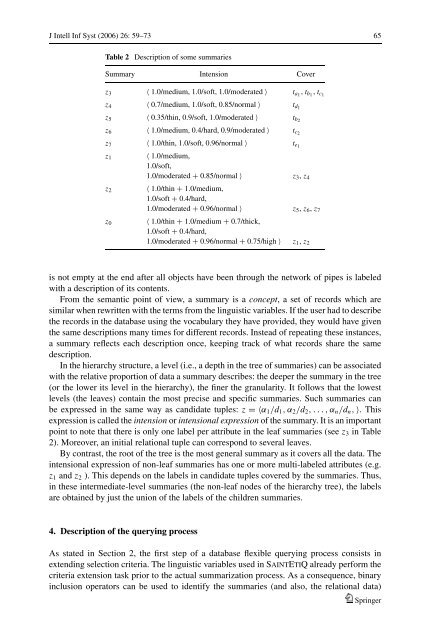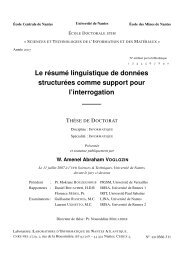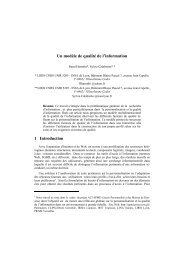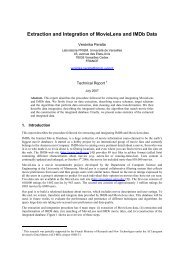You also want an ePaper? Increase the reach of your titles
YUMPU automatically turns print PDFs into web optimized ePapers that Google loves.
J Intell Inf Syst (2006) 26: 59–73 65Table 2 Description <strong>of</strong> some summariesSummary Intension Coverz 3 〈 1.0/medium, 1.0/s<strong>of</strong>t, 1.0/moderated 〉 t a1 , t b1 , t c1z 4 〈 0.7/medium, 1.0/s<strong>of</strong>t, 0.85/normal 〉 t d1z 5 〈 0.35/thin, 0.9/s<strong>of</strong>t, 1.0/moderated 〉 t b2z 6 〈 1.0/medium, 0.4/hard, 0.9/moderated 〉 t c2z 7 〈 1.0/thin, 1.0/s<strong>of</strong>t, 0.96/normal 〉 t e1z 1z 2z 0〈 1.0/medium,1.0/s<strong>of</strong>t,1.0/moderated + 0.85/normal 〉 z 3 , z 4〈 1.0/thin + 1.0/medium,1.0/s<strong>of</strong>t + 0.4/hard,1.0/moderated + 0.96/normal 〉 z 5 , z 6 , z 7〈 1.0/thin + 1.0/medium + 0.7/thick,1.0/s<strong>of</strong>t + 0.4/hard,1.0/moderated + 0.96/normal + 0.75/high 〉 z 1 , z 2is not empty at the end after all objects have been through the network <strong>of</strong> pipes is labeledwith a description <strong>of</strong> its contents.From the semantic point <strong>of</strong> view, a <strong>summary</strong> is a concept, a set <strong>of</strong> records which aresimilar when rewritten with the terms from the linguistic variables. If the user had to describethe records in the <strong>database</strong> using the vocabulary they have provided, they would have giventhe same descriptions many times for different records. Instead <strong>of</strong> repeating these instances,a <strong>summary</strong> reflects each description once, keeping track <strong>of</strong> what records share the samedescription.In the hierarchy structure, a level (i.e., a depth in the tree <strong>of</strong> summaries) can be associatedwith the relative proportion <strong>of</strong> data a <strong>summary</strong> describes: the deeper the <strong>summary</strong> in the tree(or the lower its level in the hierarchy), the finer the granularity. It follows that the lowestlevels (the leaves) contain the most precise and specific summaries. Such summaries canbe expressed in the same way as candidate tuples: z =〈α 1 /d 1 ,α 2 /d 2 ,...,α n /d n , 〉. Thisexpression is called the intension or intensional expression <strong>of</strong> the <strong>summary</strong>. It is an importantpoint to note that there is only one label per attribute in the leaf summaries (see z 3 in Table2). Moreover, an initial relational tuple can correspond to several leaves.By contrast, the root <strong>of</strong> the tree is the most general <strong>summary</strong> as it covers all the data. Theintensional expression <strong>of</strong> non-leaf summaries has one or more multi-labeled attributes (e.g.z 1 and z 2 ). This depends on the labels in candidate tuples covered by the summaries. Thus,in these intermediate-level summaries (the non-leaf nodes <strong>of</strong> the hierarchy tree), the labelsare obtained by just the union <strong>of</strong> the labels <strong>of</strong> the children summaries.4. Description <strong>of</strong> the querying processAs stated in Section 2, the first step <strong>of</strong> a <strong>database</strong> flexible querying process consists inextending selection criteria. The linguistic variables used in SAINTETIQ already perform thecriteria extension task prior to the actual summarization process. As a consequence, binaryinclusion operators can be used to identify the summaries (and also, the relational data)Springer







